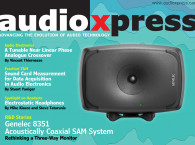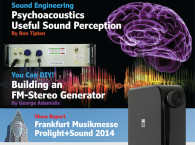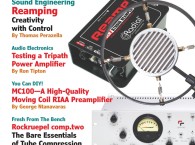
We also have two great articles on audio amplifiers. We start with the versatile TERESA Amplifier—the name is an acronym for manufacturers TExas Instruments and REneSAs, who provided the parts for the core of this amplifier. In this project by Harald Frank, we will use the latest audio MOSFETs from Renesas and a relatively new high-end drive component from National Semiconductor (which is now part of Texas Instruments). The result is worth seeing and hearing! The amplifier is a simple and cascadable Class-AB design with professional audio qualities that does not require any special experience in detailed analog circuit technology to build.
Next, we have another amplifier article, in which Gerhard Haas explains how to build a push-pull AB amplifier using KT 120 vacuum tubes. The KT 120 tube is a more powerful version of the known KT 88. Adjustments to the KT 88’s circuits enable them to be used for the KT 120. The mains transformer and output transformer must also be adjusted for the KT 120’s higher output. The article offers guidelines to building these powerful power amplifiers suitable for hi-fi equipment, guitar amplifiers, and PA systems.
This month, Richard Honeycutt’s Hollow-State Electronics column focuses on “Starved Amplifier Operation,” discussing how triode vacuum tubes can be used with very low plate voltages. However, he warns that creating such designs may require data that is not available from the datasheet and include a different design process.
Following the topic introduced in our October Standards Review column, we continue to discuss the latest Wireless Audio technologies. In the first article in this series, we briefly introduced wireless audio, discussing how the technical evolution in wireless applications followed critical applications areas—from digital radio and digital television, wireless microphones, and in-ear monitoring to Bluetooth and Wi-Fi—that made wireless audio transmission widely available. In the second part, we discuss the underlying technologies currently implemented over Bluetooth and Wi-Fi and how the latest developments in WLANs are effectively powering a new era of audio quality, reliability, and convenience for wireless audio.
As a follow up to last month’s issue, Gary Galo continues to explore 35-mm Magnetic Recording’s impact on current releases, which was inspired by an excellent presentation by audio engineer and historian Tom Fine at the 135th International Audio Engineering Society (AES) Convention in New York last year. In the first part of this article series, Gary traced the format’s evolution from its beginnings in the motion-picture industry through its adoption by several American record labels to the CD reissues of some of the Everest masters by Omega. This article continues the survey of 35-mm reissues, including Classic Records’s DVD-Audio discs of Everest recordings, Countdown Media’s high-resolution downloads of Everest material, plus Mercury catalog’s CD and SACD remasterings.
One of our November 2014 cover highlights has to be by Christophe Anet’s article on the thinking and product design considerations for the unique Genelec M Series studio monitors. For the past 35 years, Genelec has been known for its ability to introduce new and innovative technology. The Genelec’s new energy-efficient M Series takes a novel approach to monitor design and manufacturing as part of a wider ongoing sustainability program. The M Series research and development work is focused on advanced sustainability without sacrificing accuracy and reliability.
Our “Speakers” column from Mike Klasco and Steve Tatarunis continues its in-depth look at “Audio for Mobile Devices.” This article discusses the average consumer’s desire for high-end high-performance smartphones and the ways manufacturers are changing their designs to increase the audio quality. The result is feature-filled smartphones that contain high-quality audio delivery systems.
In the third article in the Nordic Audio series exploring the history of Scandinavian speaker pioneers and brands, we discuss Scan-Speak’s audio history. On “The Resilience of Scan-Speak,” Mike Klasco remembers Scan-Speak’s early innovations, ownership changes, and its unique ability to offer new technologies in an ever-changing market.
This month, our Sound Control column is dedicated to “Measurement Microphones.” Richard Honeycutt explains that to take a scientific measurement with a microphone, we must know its precise sensitivity (in volts per pascal). Since this may change over the device’s lifetime, it is necessary to regularly calibrate measurement microphones. This service is offered by some microphone manufacturers and by independent certified testing labs. However, all microphone calibration is ultimately traceable to primary standards at a national measurement institute. This article discusses some of the laboratory-standard microphones calibrated using this method, which are in turn used to calibrate other microphones through comparison calibration techniques.
Our monthly interview with industry personalities, pioneers, and visionaries, features Eric Strouth of Locomotive Audio, discussing its fascinating handmade analog audio recording solutions. As Eric himself explains, “I started Locomotive Audio really just as a hobby. But, after I realized I could blend several of my favorite things (audio recording, product design, and building, electronics) to start a new career, I decided to quit my day job as a graphic designer and go all-in!”
Your new issue of audioXpress is now available at www.gotomyxpress.com
To become a member, visit www.audioxpress.com/page/audioXpress-Subscription-Services.html.
You can also buy a single printed issue at www.cc-webshop.com.
Or you can write to us if you would like to receive a trial offer. Click here.







